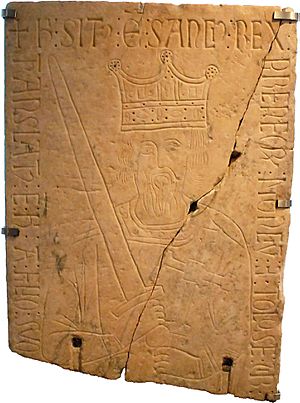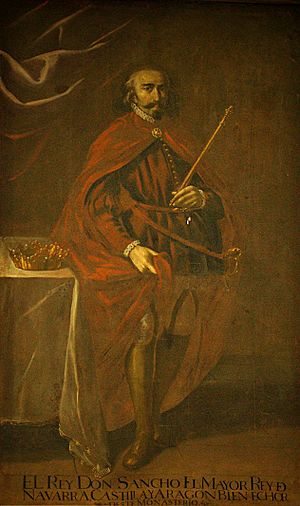Sancho III of Pamplona facts for kids
Quick facts for kids Sancho III |
|
|---|---|

The burial stone of Sancho III, bearing his effigy
|
|
| King of Pamplona | |
| Reign | 1004–1035 |
| Predecessor | García Sánchez II |
| Successor | García Sánchez III |
| Count of Aragon | |
| Reign | 1004–1035 |
| Predecessor | García Sánchez II |
| Successor | Ramiro I |
| Born | c. 992-996 |
| Died | c. 1035 |
| Burial | Monastery of San Salvador de Oña |
| Consort | Muniadona of Castile |
| Issue |
|
| House | House of Jiménez |
| Father | García Sánchez II |
| Mother | Jimena Fernández |
| Religion | Catholicism |
Sancho Garcés III (born around 992-996 – died October 18, 1035), also known as Sancho the Great, was a powerful king in what is now Spain. He ruled the Kingdom of Pamplona from 1004 until his death in 1035. He also controlled the County of Aragon and, through marriage, the regions of Castile, Álava, and Monzón.
Sancho later added more areas like Sobrarbe (in 1015), Ribagorza (in 1018), and Cea (in 1030). He even took control of the important city of León in 1034. He was the oldest son of García Sánchez II and his wife Jimena Fernández.
Contents
The Life of Sancho the Great
Early Life and Becoming King
We don't know the exact year Sancho was born, but it was likely between 992 and 996. His parents were King García Sánchez II and Queen Jimena Fernández. Sancho grew up in the monastery of Leyre, a special religious place.
His father was last mentioned in the year 1000. Sancho became king in 1004, taking over the Kingdom of Pamplona. When he first became king, he was young. A group of bishops, his mother Jimena, and his grandmother Urraca Fernández helped him rule. This group was called a council of regency.
Expanding His Kingdom
Sancho wanted to unite the Christian areas of Spain. At this time, Muslim Spain was breaking into smaller kingdoms called taifas. Around 1010, Sancho married Muniadona of Castile. She was the daughter of Sancho García of Castile, a powerful count.
In 1015, Sancho started to expand his kingdom. He took control of Sobrarbe, an area that had been under Muslim rule. He also gained control of parts of Ribagorza in 1018. He even made Berengar Raymond I of Barcelona agree to be his vassal, meaning Berengar had to show loyalty to Sancho.
Taking Over Castile
In 1016, Sancho set the border between his kingdom and Castile. This showed the good relationship he had with Castile, partly because of his marriage to Muniadona. In 1017, he became the protector of young García Sánchez of Castile.
However, things changed when Count García was killed in 1027. He was supposed to marry Sancha, the sister of King Alfonso V of León. Sancho III didn't like this marriage because it would make León more powerful. After García's death, Sancho used his role as protector to take over Castile. He made his own son, Ferdinand, the new ruler of Castile. This brought Castile under Sancho's strong influence.
Influence in Gascony
Sancho also built connections with the Duchy of Gascony, a region in what is now France. He became their suzerain, a powerful ruler who had control over them. He also helped improve a road from Gascony to León. This road was important for pilgrims traveling to Santiago de Compostela, a famous religious site. Because of this, Sancho is known as a big supporter of the Saint James Way.
After the Duke of Gascony, Sancho VI, died in 1032, Sancho the Great gained even more power in Gascony. He created new areas of rule there, like Labourd, Bayonne, and Baztán.
Taking Over León
After Bermudo III of León became king of León, Sancho arranged for his son Ferdinand to marry Sancha, Bermudo's sister. This marriage brought more land to Sancho's family. Soon, Sancho was at war with León. His armies quickly took over much of Bermudo's kingdom.
By 1034, Sancho's power was at its peak. He even captured the city of León itself. He had himself crowned king there again. His rule now stretched from Galicia in the west to Barcelona in the east. In 1035, he helped rebuild the diocese of Palencia, a church area that had been destroyed. He died on October 18, 1035, and was buried in the monastery of San Salvador de Oña.
How His Kingdom Was Divided
Before he died in 1035, Sancho divided his lands among his sons.
- His oldest son, García, became king of Navarre.
- Gonzalo received the regions of Sobrarbe and Ribagorza.
- Ferdinand had already been given Castile. He later became King of León.
- His oldest but illegitimate son, Ramiro, received lands in Aragon. He later became the first King of Aragon.
Sancho also had two daughters, Mayor and Jimena.
Sancho's Lasting Impact

Sancho moved his main home to Nájera instead of the old capital of Pamplona. As his kingdom grew, he saw himself as a European king. He made connections with leaders across the Pyrenees mountains in France.
He brought new ideas from France to Spain, including ways of ruling and church practices. He was friends with important people like the Count of Barcelona and the Duke of Gascony. He also supported the Cluniac Reforms, which were changes to how monasteries were run. Sancho also started making coins in Navarre, similar to those used in France.
Sancho's most important legacy was bringing all the Christian parts of Spain together for a short time. He ruled over León, an old capital, and Barcelona, a major city. Even though he divided his kingdom among his sons when he died, he made sure they were all from the same family, the Jiménez dynasty. This kept the kingdoms connected by blood for a long time. He made Navarre strong and independent, which helped it survive for centuries. His rule shaped the map of Spain until it was finally united much later.
Titles He Used
During his long reign, Sancho used many different titles. After he was crowned in León, he called himself rex Dei gratia Hispaniarum, which means "by the grace of God, king of the Spains." This title showed that he believed he was king over all the different kingdoms in Spain. He also sometimes used the title "Emperor," but this was rare.
Other people called him rex Ibericus or rex Navarrae Hispaniarum, meaning "king of all Iberia" or "king of Navarre and Spain." An Arab writer, Ibn Bassam, called him the "Lord of the Basques."
Family and Marriage
| Ancestors of Sancho III of Pamplona | |||||||||||||||||||||||||||||||||||||||||||||||||||||||||||||||||||||||||||||||||||||||||||||||||||||||||||||||||||||||||||||||||||||||||||||||||||||||||||||||||||||||||||||||||||||||||||||||||||||||||||||||||||||||||||||||||||||||||||||||||||||||||||||||||||||||||||||||||||||||||
|---|---|---|---|---|---|---|---|---|---|---|---|---|---|---|---|---|---|---|---|---|---|---|---|---|---|---|---|---|---|---|---|---|---|---|---|---|---|---|---|---|---|---|---|---|---|---|---|---|---|---|---|---|---|---|---|---|---|---|---|---|---|---|---|---|---|---|---|---|---|---|---|---|---|---|---|---|---|---|---|---|---|---|---|---|---|---|---|---|---|---|---|---|---|---|---|---|---|---|---|---|---|---|---|---|---|---|---|---|---|---|---|---|---|---|---|---|---|---|---|---|---|---|---|---|---|---|---|---|---|---|---|---|---|---|---|---|---|---|---|---|---|---|---|---|---|---|---|---|---|---|---|---|---|---|---|---|---|---|---|---|---|---|---|---|---|---|---|---|---|---|---|---|---|---|---|---|---|---|---|---|---|---|---|---|---|---|---|---|---|---|---|---|---|---|---|---|---|---|---|---|---|---|---|---|---|---|---|---|---|---|---|---|---|---|---|---|---|---|---|---|---|---|---|---|---|---|---|---|---|---|---|---|---|---|---|---|---|---|---|---|---|---|---|---|---|---|---|---|---|---|---|---|---|---|---|---|---|---|---|---|---|---|---|---|---|---|---|---|---|---|---|---|---|---|---|---|---|---|---|---|---|
|
|||||||||||||||||||||||||||||||||||||||||||||||||||||||||||||||||||||||||||||||||||||||||||||||||||||||||||||||||||||||||||||||||||||||||||||||||||||||||||||||||||||||||||||||||||||||||||||||||||||||||||||||||||||||||||||||||||||||||||||||||||||||||||||||||||||||||||||||||||||||||
Sancho III was married to Muniadona of Castile. She was the daughter of Sancho García of Castile, the count of Castile and Álava. They had these children:
- García Sánchez III, also called "the one from Nájera". He became King of Pamplona in 1035 and married Stephanie of Foix.
- Fernando Sánchez, known as "the Great". He was Count of Castile and later became King of León in 1037. He was even called Emperor of all Spain from 1056. He married Sancha of León.
- Jimena Sánchez, who became Queen consort of León when she married Bermudo III of León.
- Gonzalo Sánchez, who was a ruler of Sobrarbe and Ribagorza.
Before marrying Muniadona of Castile, Sancho III had a son with a woman named Sancha of Aibar:
- Ramiro Sánchez. He first received lands in Aragon and is seen as the first King of Aragon. He died in 1063.
See also
 In Spanish: Sancho Garcés III de Pamplona para niños
In Spanish: Sancho Garcés III de Pamplona para niños



